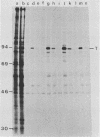Abstract
Three mouse hybridomas secreting antibodies against the undecapeptide Lys-Pro-Pro-Thr-Pro-Pro-Pro-Glu-Pro-Glu-Thr, corresponding to the carboxy terminus of simian virus 40 large T antigen, were isolated and cloned. A sensitive enzyme-linked immunosorbent assay was used to characterize the properties of the monoclonal antibodies. All three hybridomas, designated KT1, KT3, and KT4, produced antibodies that immunoprecipitated large T. The antibodies differed in their affinities for the peptide and for the native protein. Antibodies from KT3 precipitated large T better than those from KT1 or KT4. KT3 antibodies also had the highest affinity for the free peptide (5.2 X 10(6) M-1) as determined by radioimmunoassay; KT1 and KT4 antibodies had ca. 5- and 1,000-fold lower affinities, respectively. Inhibition studies with shorter peptides, overlapping the undecapeptide, revealed the approximate regions recognized by the different monoclonal antibodies. KT3 antibodies bound to a region within the carboxy-terminal six amino acids of large T. Antibodies from KT1 and KT4 reacted with sequences located further towards the amino terminus of the undecapeptide. Surprising results were obtained with KT4 antibodies. Their binding to the undecapeptide was completely inhibited by the undecapeptide itself or the carboxy-terminal hexapeptide. The carboxy-terminal pentamer, on the other hand, slightly enhanced binding, and the carboxy-terminal tetramer, Glu-Pro-Glu-Thr, was strongly stimulatory. A model for this effect is proposed. Using the enzyme-linked immunosorbent assay, we confirmed previous studies (W. Deppert and G. Walter, Virology 122:56-70, 1982) which found that antiserum against sodium dodecyl sulfate-denatured large T reacts strongly with the carboxy terminus of large T. By inhibition studies, we identified the approximate region within the undecapeptide recognized by anti-sodium dodecyl sulfate-denatured large T and compared this region with the region identified by antipeptide serum.
Full text
PDF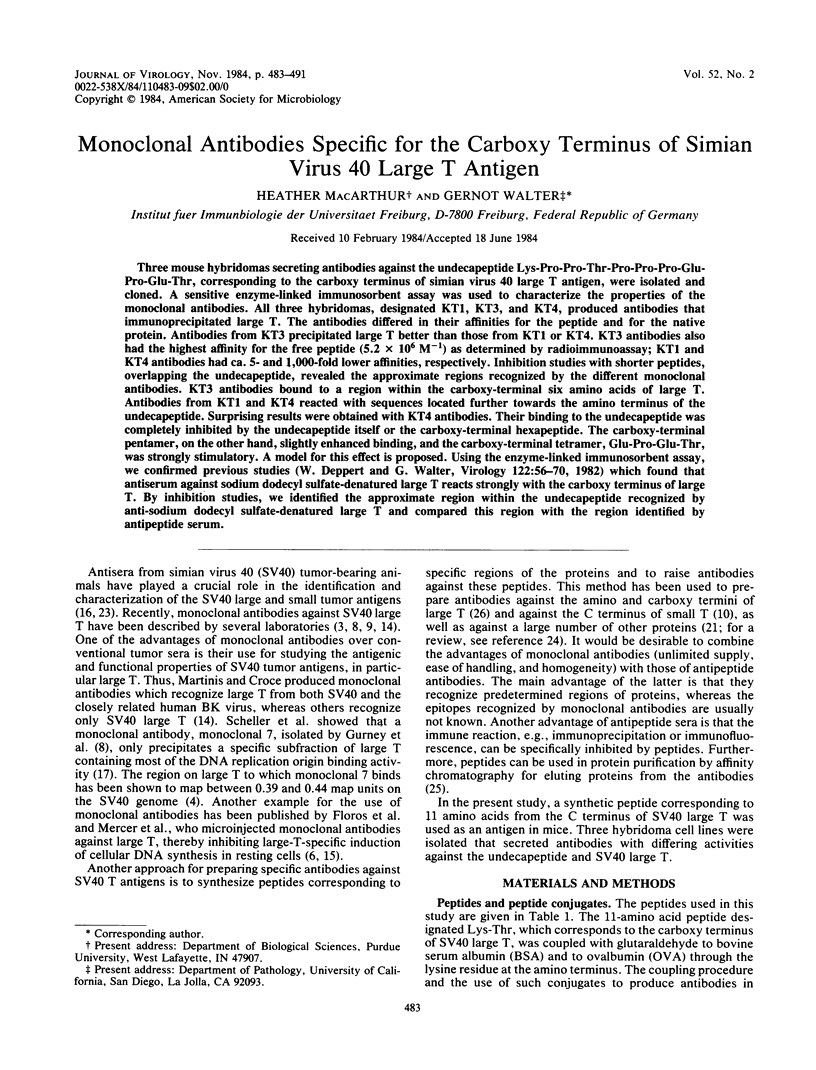

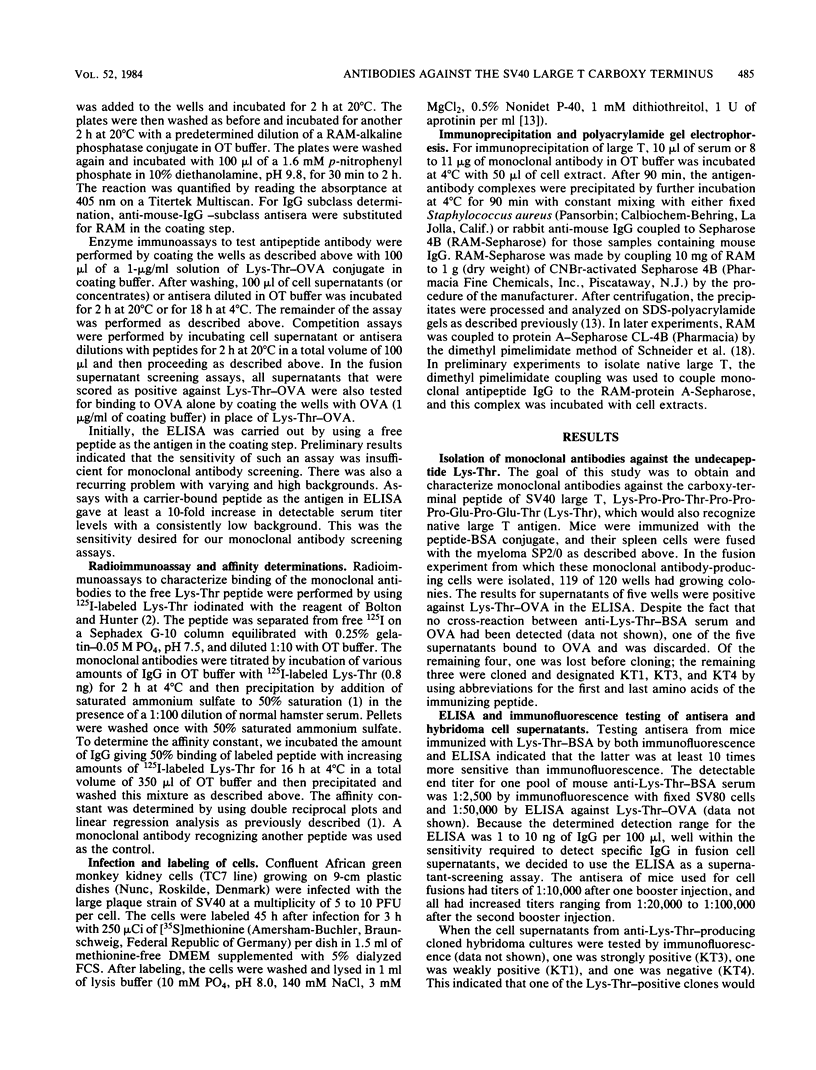
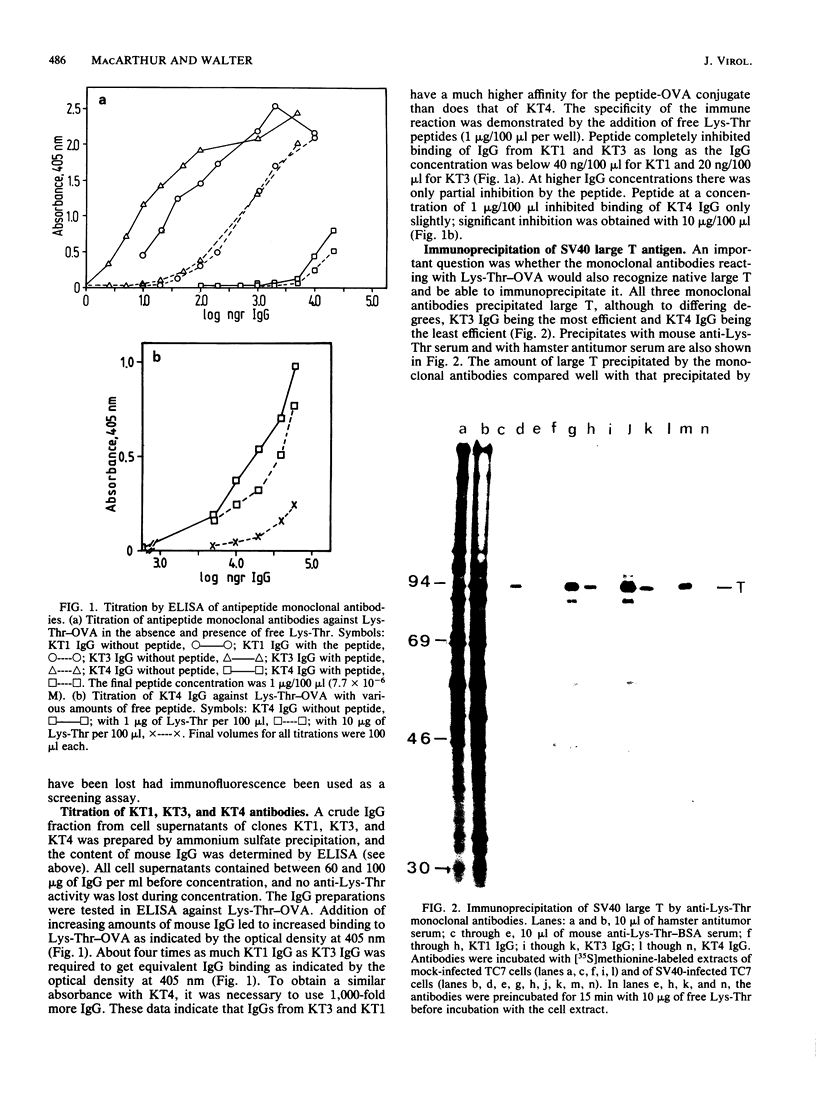
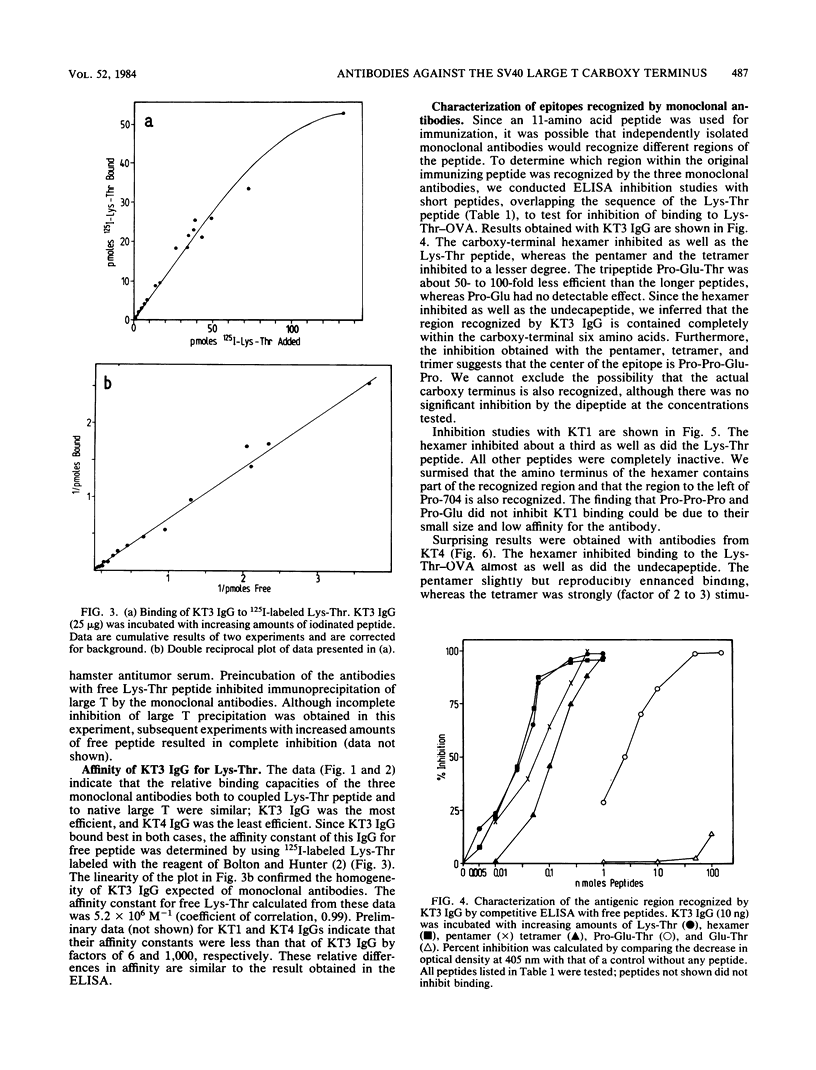
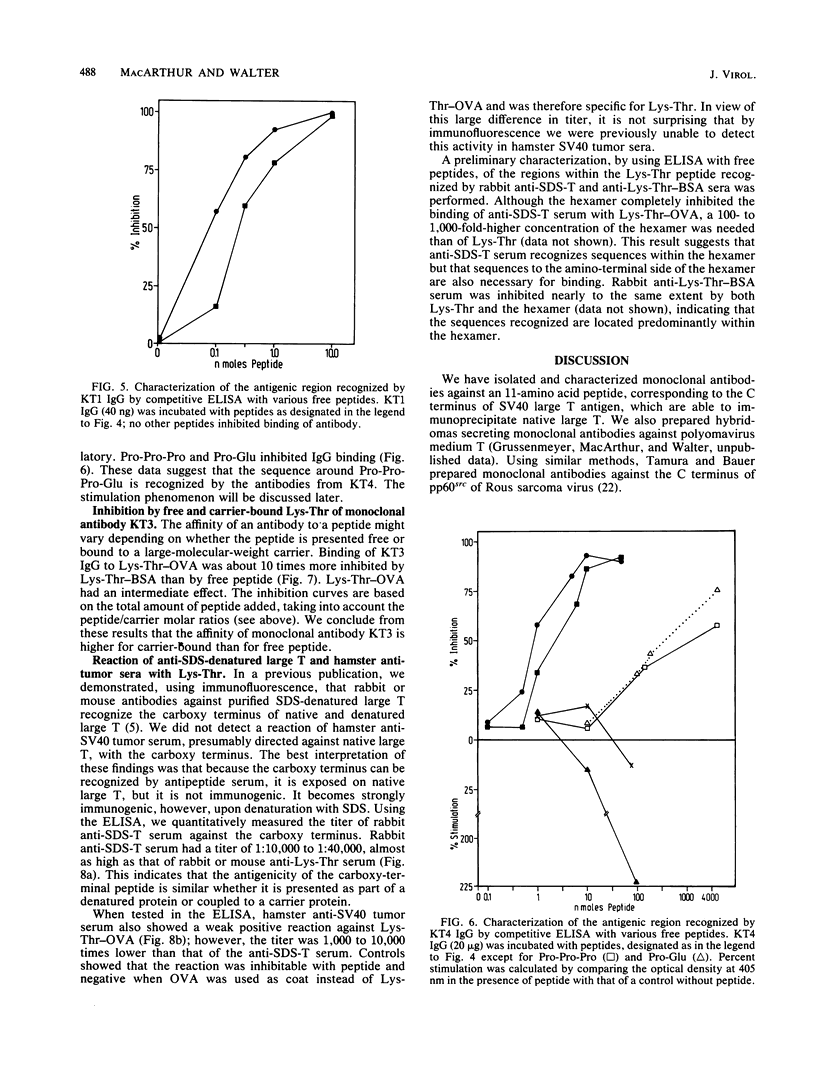
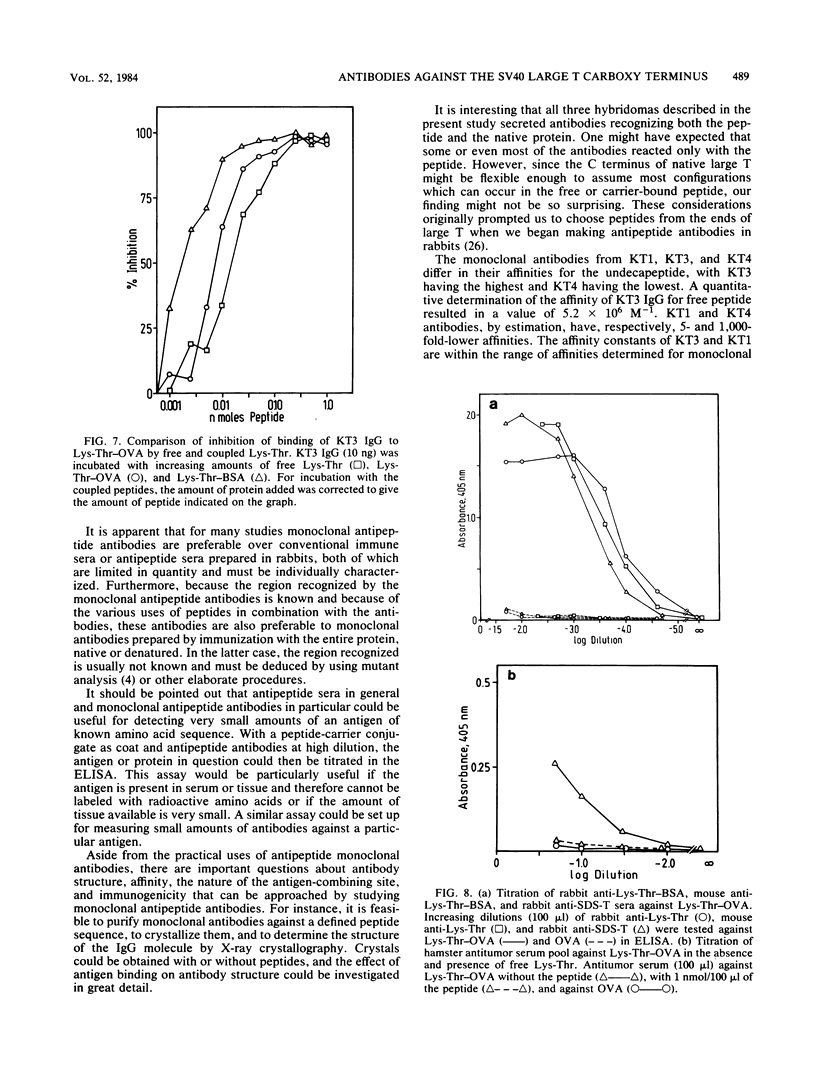
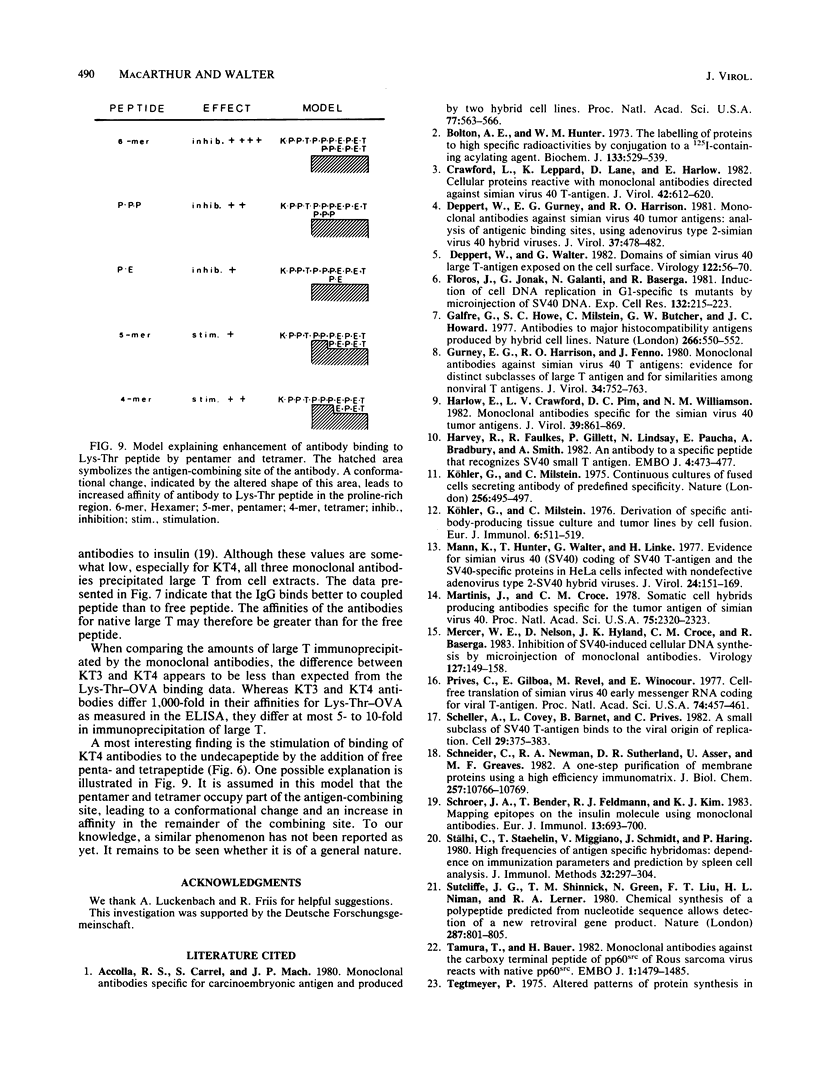

Images in this article
Selected References
These references are in PubMed. This may not be the complete list of references from this article.
- Accolla R. S., Carrel S., Mach J. P. Monoclonal antibodies specific for carcinoembryonic antigen and produced by two hybrid cell lines. Proc Natl Acad Sci U S A. 1980 Jan;77(1):563–566. doi: 10.1073/pnas.77.1.563. [DOI] [PMC free article] [PubMed] [Google Scholar]
- Bolton A. E., Hunter W. M. The labelling of proteins to high specific radioactivities by conjugation to a 125I-containing acylating agent. Biochem J. 1973 Jul;133(3):529–539. doi: 10.1042/bj1330529. [DOI] [PMC free article] [PubMed] [Google Scholar]
- Crawford L., Leppard K., Lane D., Harlow E. Cellular proteins reactive with monoclonal antibodies directed against simian virus 40 T-antigen. J Virol. 1982 May;42(2):612–620. doi: 10.1128/jvi.42.2.612-620.1982. [DOI] [PMC free article] [PubMed] [Google Scholar]
- Deppert W., Gurney E. G., Harrison R. O. Monoclonal antibodies against simian virus 40 tumor antigens: analysis of antigenic binding sites, using adenovirus type 2-simian virus 40 hybrid viruses. J Virol. 1981 Jan;37(1):478–482. doi: 10.1128/jvi.37.1.478-482.1981. [DOI] [PMC free article] [PubMed] [Google Scholar]
- Deppert W., Walter G. Domains of simian virus 40 large T-antigen exposed on the cell surface. Virology. 1982 Oct 15;122(1):56–70. doi: 10.1016/0042-6822(82)90377-4. [DOI] [PubMed] [Google Scholar]
- Floros J., Jonak G., Galanti N., Baserga R. Induction of cell DNA replication in G1-specific ts mutants by microinjection of SV40 DNA. Exp Cell Res. 1981 Mar;132(1):215–223. doi: 10.1016/0014-4827(81)90097-5. [DOI] [PubMed] [Google Scholar]
- Galfre G., Howe S. C., Milstein C., Butcher G. W., Howard J. C. Antibodies to major histocompatibility antigens produced by hybrid cell lines. Nature. 1977 Apr 7;266(5602):550–552. doi: 10.1038/266550a0. [DOI] [PubMed] [Google Scholar]
- Gurney E. G., Harrison R. O., Fenno J. Monoclonal antibodies against simian virus 40 T antigens: evidence for distinct sublcasses of large T antigen and for similarities among nonviral T antigens. J Virol. 1980 Jun;34(3):752–763. doi: 10.1128/jvi.34.3.752-763.1980. [DOI] [PMC free article] [PubMed] [Google Scholar]
- Harlow E., Crawford L. V., Pim D. C., Williamson N. M. Monoclonal antibodies specific for simian virus 40 tumor antigens. J Virol. 1981 Sep;39(3):861–869. doi: 10.1128/jvi.39.3.861-869.1981. [DOI] [PMC free article] [PubMed] [Google Scholar]
- Harvey R., Faulkes R., Gillett P., Lindsay N., Paucha E., Bradbury A., Smith A. E. An antibody to a synthetic peptide that recognises SV40 small-t antigen. EMBO J. 1982;1(4):473–477. doi: 10.1002/j.1460-2075.1982.tb01193.x. [DOI] [PMC free article] [PubMed] [Google Scholar]
- Köhler G., Milstein C. Continuous cultures of fused cells secreting antibody of predefined specificity. Nature. 1975 Aug 7;256(5517):495–497. doi: 10.1038/256495a0. [DOI] [PubMed] [Google Scholar]
- Köhler G., Milstein C. Derivation of specific antibody-producing tissue culture and tumor lines by cell fusion. Eur J Immunol. 1976 Jul;6(7):511–519. doi: 10.1002/eji.1830060713. [DOI] [PubMed] [Google Scholar]
- Mann K., Hunter T., Walter G., Linke H. Evidence for simian virus 40 (SV40) coding of SV40 T-antigen and the SV40-specific proteins in HeLa cells infected with nondefective adenovirus type 2-SV40 hybrid viruses. J Virol. 1977 Oct;24(1):151–169. doi: 10.1128/jvi.24.1.151-169.1977. [DOI] [PMC free article] [PubMed] [Google Scholar]
- Martinis J., Croce C. M. Somatic cell hybrids producing antibodies specific for the tumor antigen of simian virus 40. Proc Natl Acad Sci U S A. 1978 May;75(5):2320–2323. doi: 10.1073/pnas.75.5.2320. [DOI] [PMC free article] [PubMed] [Google Scholar]
- Mercer W. E., Nelson D., Hyland J. K., Croce C. M., Baserga R. Inhibition of SV40-induced cellular DNA synthesis by microinjection of monoclonal antibodies. Virology. 1983 May;127(1):149–158. doi: 10.1016/0042-6822(83)90379-3. [DOI] [PubMed] [Google Scholar]
- Prives C., Gilboa E., Revel M., Winocour E. Cell-free translation of simian virus 40 early messenger RNA coding for viral T-antigen. Proc Natl Acad Sci U S A. 1977 Feb;74(2):457–461. doi: 10.1073/pnas.74.2.457. [DOI] [PMC free article] [PubMed] [Google Scholar]
- Scheller A., Covey L., Barnet B., Prives C. A small subclass of SV40 T antigen binds to the viral origin of replication. Cell. 1982 Jun;29(2):375–383. doi: 10.1016/0092-8674(82)90154-4. [DOI] [PubMed] [Google Scholar]
- Schneider C., Newman R. A., Sutherland D. R., Asser U., Greaves M. F. A one-step purification of membrane proteins using a high efficiency immunomatrix. J Biol Chem. 1982 Sep 25;257(18):10766–10769. [PubMed] [Google Scholar]
- Schroer J. A., Bender T., Feldmann R. J., Kim K. J. Mapping epitopes on the insulin molecule using monoclonal antibodies. Eur J Immunol. 1983 Sep;13(9):693–700. doi: 10.1002/eji.1830130902. [DOI] [PubMed] [Google Scholar]
- Stähli C., Staehelin T., Miggiano V., Schmidt J., Häring P. High frequencies of antigen-specific hybridomas: dependence on immunization parameters and prediction by spleen cell analysis. J Immunol Methods. 1980;32(3):297–304. doi: 10.1016/0022-1759(80)90194-5. [DOI] [PubMed] [Google Scholar]
- Sutcliffe J. G., Shinnick T. M., Green N., Liu F. T., Niman H. L., Lerner R. A. Chemical synthesis of a polypeptide predicted from nucleotide sequence allows detection of a new retroviral gene product. Nature. 1980 Oct 30;287(5785):801–805. doi: 10.1038/287801a0. [DOI] [PubMed] [Google Scholar]
- Tamura T., Bauer H. Monoclonal antibody against the carboxy terminal peptide of pp60src of Rous sarcoma virus reacts with native pp60src. EMBO J. 1982;1(12):1479–1485. doi: 10.1002/j.1460-2075.1982.tb01343.x. [DOI] [PMC free article] [PubMed] [Google Scholar]
- Voller A., Bidwell D. E., Bartlett A. Enzyme immunoassays in diagnostic medicine. Theory and practice. Bull World Health Organ. 1976;53(1):55–65. [PMC free article] [PubMed] [Google Scholar]
- Walter G., Hutchinson M. A., Hunter T., Eckhart W. Purification of polyoma virus medium-size tumor antigen by immunoaffinity chromatography. Proc Natl Acad Sci U S A. 1982 Jul;79(13):4025–4029. doi: 10.1073/pnas.79.13.4025. [DOI] [PMC free article] [PubMed] [Google Scholar]
- Walter G., Scheidtmann K. H., Carbone A., Laudano A. P., Doolittle R. F. Antibodies specific for the carboxy- and amino-terminal regions of simian virus 40 large tumor antigen. Proc Natl Acad Sci U S A. 1980 Sep;77(9):5197–5200. doi: 10.1073/pnas.77.9.5197. [DOI] [PMC free article] [PubMed] [Google Scholar]



